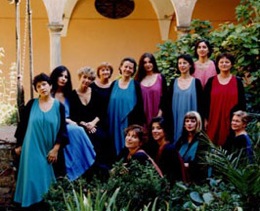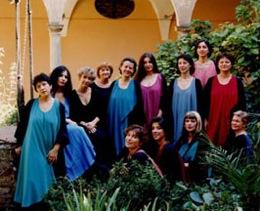
Exploiting the idea of passionate activity underneath a sacred surface, Capella Artemisia’s program titled “Soror Mea, Sponsa Mea” (My sister, my spouse) focused on settings of the Song of Songs, those most sensual of biblical texts. Their chosen composers — nuns themselves, or else outside composers writing specifically for the convent — cultivated highly evocative music to match these plangent texts on the virtues of Jesus, Mary, and other exalted figures. Who knew music by and for nuns could be so exciting?
The performance itself seemed to capture a sense of enclosure and mystery these nuns might themselves have felt. Much of the repertory, particularly in the program’s first half, had a distinctly intimate feel, with delicate lyricism and frequent antiphonal gestures imbuing an impression of affectionate conversation. Vocally, the singers (Elena Biscuola, Phoebe Jevtovic Alexander, Anna Simboli, and Smith herself) tend toward darker hues, their smoky timbres made even richer by singing in close, intense harmonies. Joined by two outstanding instrumentalists, Baroque harpist Maria Christina Cleary and organist Miranda Aureli, they could easily pass as their own close-knit sisterhood, luxuriating in the glow of a sumptuous repertory.
As found so often in Italian vocal music of this era, dramatic text declamation and contrasting emotional affects featured prominently in the program selections. From the vivid Surge propera amica mea (Arise my love) of Raphaella Aleotti, where the call to action is buttressed by propulsive rhythmic energy, to Maria Xaveria Perucona’s Propera veni dilecte mi (Come, my beloved), with successive melodies led by different voice parts and striking recitative-like sections detailing the narrator’s stark desire for living in death with Jesus, Capella Artemisia took full advantage of these pieces’ rich expressive possibilities.
Soloists Shine
Each performer also had her own moment in the spotlight. Biscuola’s rich, honeyed alto and impassioned delivery breathed life into Alba Tressina’s Vulnerasti cor meum (You have ravished my heart); her vivid declamation and carefully nuanced phrases made this piece a standout of the evening. Jevtovic Alexander brought a light, graceful quality to Lucrezia Orsina Vizzana’s Sonet vox tua (Let your voice sound), while Smith’s rendition of Natale Monferrato’s languid Marian paean O quam pulchra es (Behold, you are fair) nicely accented the work’s multitudinous expressive character, from meandering melodic ruminations on Mary’s beauty to more recitative-like urging.Jevtovic Alexander and Simboli joined for an effective, antiphonally spaced performance of Giovanni Paolo Cima’s Surge propera amica mea, with each singer paired with one of the instrumentalists, and the echo effect marred only by Simboli’s sharpness in pitch. Two instrumental pieces based on the famous La Monica theme, Ottavio Bargnani’s Canzon XV sopra la Monica and Girolamo Frescobaldi’s Partite sopra la Monicha, were masterfully delivered by Cleary and Aureli.
The dialogue Psallite superi (Sing, you above), by Chiara Margarita Cozzolani, proved a charming closer. A naive initiate, portrayed by Smith, poses several questions about the identity of a certain remarkable woman, the other singers each responding in turn with glowing portrayal of Mary’s virtues. It neatly encapsulated the sense of engagement and community characterizing the concert as a whole.

